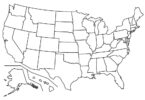Questions about White Bears:
What is the scientific name for the polar bear?
(a) Ursus maritimus
(b) Panthera leo
(c) Canis lupus
(d) Felis catus
What is their primary food source?
(a) Seals
(b) Fish
(c) Berries
(d) Penguins
What is a critical component of the polar bear’s habitat?
(a) Deep caves for hibernation
(b) Large bodies of freshwater lakes
(c) Vast stretches of sand dunes
(d) Sea ice for hunting and resting
What is the average length of an adult polar bear (white bear)?
(a) Around 3-4 feet
(b) Around 6-8 feet
(c) Around 10-12 feet
(d) Around 15-18 feet
What is the average weight of adult male ice bears?
(a) Around 200-400 pounds
(b) Around 500-800 pounds
(c) Around 1,000-1,500 pounds
(d) Around 2,000-3,000 pounds
What is the average height of a standing adult polar bear at the shoulder?
(a) Around 2-3 feet
(b) Around 4-5 feet
(c) Around 6-7 feet
(d) Around 8-9 feet
What is the primary threat to white bear populations caused by climate change?
(a) Increased availability of food sources
(b) Increased groups hunting
(c) Reduced sea ice coverage
(d) Greater fishes population growth
How long can they stay submerged underwater while hunting?
(a) Up to 1 minute
(b) Up to 3 minutes
(c) Up to 5 minutes
(d) Up to 10 minutes
Which of the following hunting methods do white bear commonly use to catch seals?
(a) Chasing seals on land
(b) Diving underwater to catch seals by surprise
(c) Stealing them from other predators
Which of the following adaptations allows polar bears to thrive in a cold Arctic environment?
(a) White fur for camouflage
(b) Thick layer of blubber for insulation
(c) Large paws for efficient swimming
(d) All of the above
Which of the following organizations is responsible for monitoring and assessing the status of their populations?
(a) WWF
(b) IUCN
(c) UNEP
(d) IPBCC)
Which of the following is their natural predator?
(a) Orcas (killer whales)
(b) Wolves
(c) Bald eagles
(d) Arctic foxes
What is the approximate total lifespan of a polarbear?
(a) 15-20 years
(b) 25-30 years
(c) 35-40 years
(d) 45-50 years
How long is the gestation period of a pregnant white bear?
(a) 3-4 months
(b) 5-6 months
(c) 7-8 months
(d) 9-10 months
How long does a cub typically stay with its mother?
(a) 1 year
(b) 2 years
(c) 3 years
(d) 4 years
What is the primary habitat of white bears?
(a) Rainforests
(b) Deserts
(c) Icy Tundra and Arctic regions
(d) Grasslands
How do orcas (killer whales) prey on these bears?
(a) By ambushing them on land
(b) By hunting them in packs on sea ice
(c) By stealing their food sources
(d) By attacking their cubs
How do polar bears survive in their cold environment?
(a) They migrate to warmer regions during winter.
(b) They hibernate in dens.
(c) They have a thick layer of blubber and fur for insulation.
(d) They rely on metabolic heat production.
When are white bear cubs usually born?
(a) Spring
(b) Summer
(c) Fall
(d) Winter






